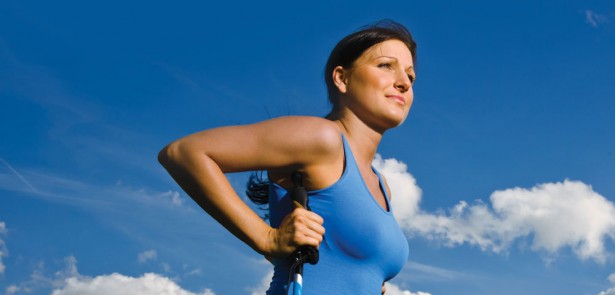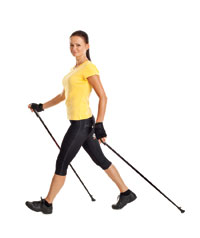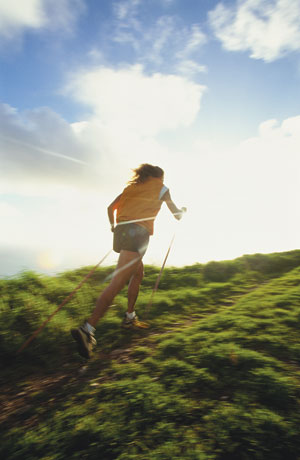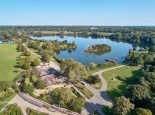Walk this way

As one of the fastest growing fitness sports in the world, Nordic Walking has captured people’s imaginations with its low impact but whole-body benefits. David Castle picked up his poles for a crash course in technique – and found it wasn’t just a walk in the park
As a self-confessed ‘runaholic’, the thought of walking as my sport of choice was something of anathema to me. So, tasked with writing a piece on the growing sport of Nordic walking, I didn’t exactly jump at the chance. But, after a morning’s session up and down the hills in the local park, I realised what I’d been missing! My experience was made all the better given that I was in the capable hands of Master Trainer Martin Christie, who has been involved in the promotion and development of Nordic Walking in the UK since 2003 and has trained in excess of 400 instructors, individuals and employees of Primary Care Trusts and local authorities.
Getting started
How hard can it be, I thought? After all, it’s only walking. As I discovered, not only is there technique involved, but it’s an all over body workout designed to get your pulse racing.
Nordic Walking isn’t particularly equipment intensive – you can wear normal training shoes or off-road equivalents, and whatever kit suits the temperature (we were blessed with a glorious day, so it was T-shirts and tights). The only extra piece of kit is the poles. For our training session, we were using top-of-the-range Leki poles (the Speed Pacer Vario priced around £100) a carbon-fibre pole that is extremely light and rigid, as well as being adjustable.
Technique matters
Geared up and ready to go, Martin explained the basics of the technique. Nordic Walking’s chief attraction is that, unlike normal walking, it exercises the whole of a person’s body, rather than just their legs. As participants use their arms to push off from their flexible poles, the whole range of upper-body muscles is used, helping to strengthen the back and abdominal muscles.
When Nordic Walking, you use your legs, your arms, the rear part of your shoulders, and your chest and back muscles. Although you are using more muscles and doing more exercise, the effort is spread across your whole body and, therefore, Nordic Walking can actually feel easier and less tiring than normal walking (although not for me!)
Martin reckons that to truly nail the technique takes around six weeks, but most people can pick up the basics in a one one-hour session (although some people take to it easier than others!). We started by holding the poles loosely at our side and walking with opposite arm and leg (an action similar to marching). Unlike running, the arm movement comes from the shoulder, and, as we progressed, we brought the poles into play, planting them just behind the line of the hip to propel us forward. It’s a bit like golf – the more you think about it, the harder it gets. I found that it was best to relax and just let the natural momentum of the action carry me forward.
What are the benefits?
Enthusiasts say it uses 90 per cent of the body’s skeletal muscles, compared to, say, swimming which uses 35 per cent or running which uses 70 per cent, and because the arms take more of the strain, a lighter load is placed on the knees and other lower body joints. This has made the activity popular with older outdoor enthusiasts, although Martin is actively promoting the sport with younger individuals.
“Nordic walking can be used as effective cross training, allowing recovery from the impact of running while eliciting greater cardiovascular responses than just walking,” says Martin.
“High intensity training with the poles (hills or running) can make a very time effective training session. Nordic Walking can be used to improve the aerobic fitness of the upper body, which will improve overall fitness and may improve running performance.
What’s the verdict?
Nordic walking is great fun and an interesting experience. As a recuperative tool to help you on the road back to fitness, it’s got to be more interesting (and healthier) than strapping a buoyancy aid on and ‘running’ in the pool.
And, for people looking to bolster their training programmes with an all-round activity, it’s certainly worth a look. I certainly felt the ‘benefits’ the next day! The only negatives are that you might feel a little awkward Nordic Walking in urban areas (shouts of ‘Where’s your skis?’ are not uncommon) but then how many times have I heard ‘Run Forrest, run!’, and that’s never stopped me. Now, where are my poles? I’m off to hone my technique…
 Benefits of Nordic Walking
Benefits of Nordic Walking
Activates about 90% of the human muscular system.
Not only helps the aerobic fitness but also the strength of the upper body.
Is great as part of a weight-loss programme.
Fantastic way to rehabilitate after sports injuries.
Improves co-ordination.
Is very fast and easy to learn in the basic form.
Can be done all year round.
Where can you do it?
Every Friday at Bretton Park – www.activeedgesolutions.co.uk
Werrington Sports Centre – 07901 937 665
















